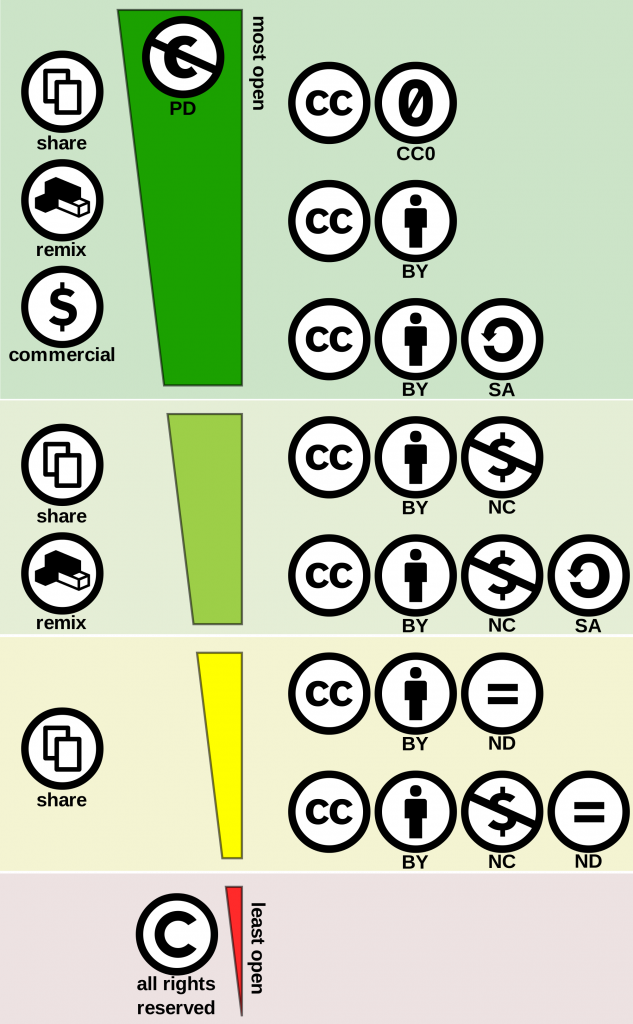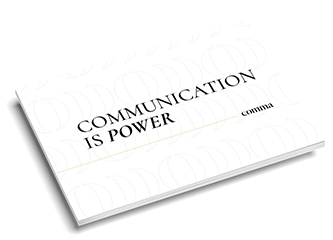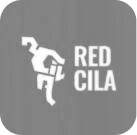Creative Commons is a set of licences issued by the copyright owner to allow anyone in the world to use their protected work in any manner consistent with that licence;
The Creative Commons are basically standard form licence agreements that can be attached to a work to allow its use in certain circumstances without the need to contact the author or negotiate terms of use.
 What are the advantages of Creative Commons?
What are the advantages of Creative Commons?
Creative Commons licenses are especially useful for people who want to disseminate and share their work as widely as possible on the internet, as the rights granted are broad and designed to facilitate sharing, as well as the mashups and derivative works. Let’s take a look at all its advantages:
It encourages collaboration and the exchange of ideas
One of the main advantages of using Creative Commons licences is that they promote collaboration and the exchange of ideas; By allowing others to use and share your work legally, you facilitate the creation of joint projects, the improvement of existing works and the development of new ideas from your original work;
Broaden the dissemination of your works
Creative Commons licences allow a wider dissemination of your works, as people can share, distribute and use your content legally; This increases the visibility of your work, reaching audiences you would not otherwise have access to; In addition, when shared with proper attribution, your name as the creator will be linked to the work, giving you recognition and potentially more opportunities;
Stimulates creativity and innovation
By allowing others to use your work as a starting point, Creative Commons licences encourage creativity and innovation; Other creators can be inspired by your work to generate new ideas, add value or adapt it to different contexts; This creates a cycle of feedback and continuous improvement, driving creative progress and the generation of original content;
It facilitates education and access to knowledge
Creative Commons licences are especially beneficial in education and academia; By using these licences to share educational materials, research or teaching resources, you contribute to the democratisation of knowledge; Students, teachers and professionals can freely access, use and adapt these resources, facilitating teaching, learning and the creation of new knowledge;
Avoid legal problems and confusion;
By using Creative Commons licences, you avoid legal problems and confusion related to the use and distribution of your works; These licences provide a clear, legal framework for specifying which rights you reserve and which you are willing to share; This gives certainty both to you as a creator and to those who wish to use your works, as the terms of use are set out in a transparent manner;
It contributes to building a global community
Creative Commons has created a global community of creators who use these licences to share their works; By joining this community, you connect with other artists, writers, musicians, researchers and more who share similar interests in the responsible and ethical use of intellectual property; This allows you to collaborate, receive feedback and expand your creative network;
Creative commons as a non-profit entity
Since Creative Commons is a non-profit organisation and not a licensing entity, monitoring of uses to ensure consistency with the licensing and enforcement of any infringement is up to the owner of the copyright who chooses to use the Creative Commons licence;
This is different from other licensing entities and collecting societies that license specific uses of their members’ works for particular terms; Such entities are responsible for monitoring and ensuring compliance with the terms of the licence, as well as collecting and distributing royalty payments to authors;
Elements of Creative Commons licences
Creative Commons licences are made up of several interrelated elements, which are:
Attribution or Acknowledgement
Attribution requires us to identify the author of a work by name, regardless of the use made of it; Even if you create a derivative work based on an original work licensed under Creative Commons, you must credit the author of the original work;
This is the only element found in all Creative Commons licences and is identified by the acronym BY.
Non Commercial
This attribute allows the creator to authorise any type of use, but reserves the right to exploit the work economically; In other words, the author can economically exploit his work, but the user cannot;
It is the monetary compensation or economic benefit that determines the “commercial” character; For example, photocopying a book for private use will not be a commercial use, but photocopying a book for sale to the public will be a commercial use; It is identified by the acronym NC;
Share Alike or license Alike
If this element is included, it means that users are allowed to create derivative works, i.e. they can translate, modify or adapt the work and distribute those new works, as long as they are distributed under the same conditions under which the original work was licensed;
Thus, the so-called copyleft, which prevents derivative works from becoming governed by the default system of protection under the law. It is identified by the acronym SA.
No Derivative or No Derivative
This element prohibits the making of derivative works of the original work; Thus, the inclusion of this element authorises users to copy the work and to distribute copies (for commercial or non-commercial purposes, depending on other elements), but without the possibility to intervene in the original work; It is identified by the acronym ND.
Types of Creative Commons licences
There are currently six types of Creative Commons licences, seven if we add CC Zero, which corresponds to public domain works;

CC Zero
Works in the public domain; The work is released universally and to the extent permitted by law from all its intellectual property rights, including all related rights.
The work may be copied, modified, distributed and communicated to the public, including for commercial purposes, without permission;
CC BY – Acknowledgement
This licence allows anyone to distribute, remix, adapt and redesign from a work, even for profit, as long as the authorship of the original creation is acknowledged; After the zero licence, this is the most flexible licence offered and is recommended for maximum dissemination and use of the licensed materials;
CC BY-SA Attribution – share alike
This licence allows others to remix, adapt and build upon your work, even for commercial purposes, as long as they credit you and license their new creations under the same terms; This licence is often compared to the free and open source software “copyleft” licences;
All new works based on his will carry the same licence, so any derivatives will also allow commercial use; This is the licence used by Wikipedia, and is recommended for materials that would benefit from incorporating content from Wikipedia and similarly licensed projects;
CC BY-ND Attribution – no derivative works;
This licence allows others to re-use the work for any purpose, including commercially; however, it may not be shared with others in adapted form, and credit must be given to you;
CC BY-NC Attribution – non-commercial
This licence allows others to remix, adapt and build upon our creation on a non-commercial basis; Although new derivative works must also acknowledge our authorship and be non-commercial, they do not have to license their derivative works on the same terms;
CC BY-NC-SA Attribution – non-commercial – share alike
This licence allows others to remix, adapt and build upon your work on a non-commercial basis, as long as they grant us proper authorship and also license their new creations under the same terms;
CC BY-NC-ND Attribution – non-commercial – no derivative work
This licence is the most restrictive of the six main licences, only allowing others to download the works and share them with others, provided that authorship is acknowledged, but they may not be changed in any way or used commercially;
How can I use a Creative Commons licence?
Before proceeding to apply a licence, there are some Creative Commons considerations and whether our work conforms to them. To use a Creative Commons (CC) licence for your creations, follow these steps:
- Visit the Creative Commons website: Visit the official Creative Commons website at https://creativecommons.org/ for detailed information on the different licences and to select the one that best suits your needs;
- Choose the right licence: On the Creative Commons website, you will find a description of the different licences available; Read carefully the characteristics of each licence and choose the one that suits your preferences; Some licences allow commercial use, while others require attribution or prohibit the creation of derivative works; Select the licence that clearly defines the rights you wish to grant to other users;
- Generate the HTML code or URL for your licence: Once you have selected a licence, Creative Commons will provide you with a specific HTML code or URL representing your chosen licence; You can insert this code on your website, blog or wherever you want the licence to appear; If you opt for the URL, you can link to it from any online location where your work is displayed;
- Add attribution (if applicable): If you have chosen a licence that requires attribution (e.g. the Attribution licence), make sure you properly include attribution data in your work. This involves mentioning the name of the original author, the title of the work and, if possible, providing a link to the CC licence used; Proper attribution helps give credit to the original creator and complies with licensing requirements;
- Share your work: Once you have applied the Creative Commons licence to your work and added attribution if necessary, you are ready to share your work with the world; You can publish it on your website, blog, social media platforms or any other medium you wish to use; Make sure that the CC licence is clearly visible and accessible so that users can understand the rights and restrictions associated with your work;
Remember to check the terms of the licence you choose to make sure you understand how you can use other people’s work and how others can use yours; Also, please note that applying a Creative Commons licence is a voluntary act and only applies to the works you wish to share under those terms; You are free to use different licences for different works if you wish;
 The license chooser will invite us to choose options among the different elements that make up the licence; once this step is done, we will obtain an HTML code that we can insert in our website.
The license chooser will invite us to choose options among the different elements that make up the licence; once this step is done, we will obtain an HTML code that we can insert in our website.
CC Search, the Creative Commons search engine
CC Search is a tool for discovering and using openly licensed and public domain works, offering over 300 million images from open APIs and the Common Crawl.
It goes beyond simple search to aggregate results across multiple public repositories into a single catalogue, and facilitates reuse through features such as machine-generated tags and one-click attribution;
 At the moment this tool only searches for images, but there are plans to add other types of media, such as open text and audio, with the ultimate goal of providing access to all 1.4 billion CC-licensed and public domain works on the web;
At the moment this tool only searches for images, but there are plans to add other types of media, such as open text and audio, with the ultimate goal of providing access to all 1.4 billion CC-licensed and public domain works on the web;
Some examples of works or creations with CC licences;
To better understand the characteristics of the different Creative Commons licences, let’s review some well-known examples:
Pixabay (CC Zero)
The well-known free image search engine Pixabay is a good example of CC Zero, as all their creations are completely royalty-free. As you know, this licence allows any use of the work and it is not even necessary to mention the authorship of the original;
Plos (CC BY)
The Public Library of Science (PLOS) launched in 2003 a non-profit scientific and medical publishing project that provides scientific and medical individuals with high-quality, high-profile journals in which to publish their most important work. PLOS publishes approximately 50 000 CC BY articles per year;
Wikipedia (CC BY – SA)
Wikipedia y Wikimedia Commons are a good example of the use of the CC BY – SA license. Many of the media accompanying Wikipedia articles, such as photos and illustrations, are also licensed under CC BY-SA or a more permissive license;
Another well-known example with the CC BY – SA licence is Arduino, an open source computer chip.
Behance (CC BY – ND)
Behance is a good example of the use of a CC BY – ND licence; It is an important platform and community for designers and other creative professions, frequently used by companies and organisations to identify and find talent;
Brooklyn Museum (CC BY – NC)
According to the director of the Brooklyn Museum, Shelley Bernstein, “every object on the Museum’s collections pages has information about its rights status, including those that are understood to have no known copyright. At the same time, we have taken a further step in the current direction of opening up more content and, with the images and text for which we own the copyright, we have changed our default Creative Commons licence on the website from a CC BY-NC-ND to a CC BY-NC, to allow for greater reuse of the materials;
Jonathan Worth (CC BY – NC – SA)
Jonathan Worth is a freelance commercial photographer who has licensed his photographs under the CC BY-NC-SA license; His work has appeared in numerous publications and exhibitions, including the permanent collection of the National Portrait Gallery;
Ted Talks (CC BY – NC – ND)
The popular TED talks use the CC BY – NC – ND licence, which means they cannot be modified or used commercially. However, TED encourages translations through its Open Translation Project;
Other interesting resources on Creative Commons
These resources will help you find content, music, images and other resources under Creative Commons licences to use in your projects; There are also tools to generate appropriate attribution and educational resources to learn more about Creative Commons and its application in different contexts;
Remember to review the terms and conditions of each resource and ensure that you comply with attribution requirements and other licensing terms when using works under Creative Commons licences;
Creative Commons content search websites:
- Creative Commons Search: https://search.creativecommons.org/
- Flickr Creative Commons: https://www.flickr.com/creativecommons/
- Wikimedia Commons: https://commons.wikimedia.org/
Image and photo libraries:
- Unsplash: https://unsplash.com/
- Pixabay: https://pixabay.com/
- Pexels: https://www.pexels.com/
Music and sound banks:
- Free Music Archive: https://freemusicarchive.org/
- YouTube Audio Library: https://www.youtube.com/audiolibrary/music
- SoundCloud Creative Commons: https://soundcloud.com/creativecommons
Collaboration and remix platforms:
- ccMixter: https://ccmixter.org/
- Jamendo: https://www.jamendo.com/
- Bandcamp: https://bandcamp.com/
Tools to generate appropriate attributions:
- Creative Commons License Chooser: https://creativecommons.org/choose/
- OpenAttribute: https://openattribute.com/
- Attribution Generator: https://www.attributegenie.com/
Communities and social networks related to Creative Commons:
- Creative Commons Network: https://network.creativecommons.org/
- Reddit Creative Commons: https://www.reddit.com/r/creativecommons/
- CC Global Summit: https://summit.creativecommons.org/
Related organisations and projects:
- Wikimedia Foundation: https://wikimediafoundation.org/
- Open Knowledge Foundation: https://okfn.org/
- Internet Archive: https://archive.org/
Documentation and educational resources on Creative Commons:
- Creative Commons Learn: https://learn.creativecommons.org/
- CC Certificate: https://certificates.creativecommons.org/
- Creative Commons Wiki: https://wiki.creativecommons.org/







